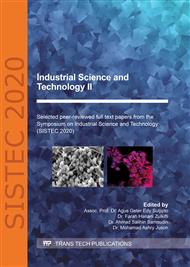[1]
MPOB 2019, Industry Development Unit, Economics & Industry Development Division Malaysian Palm Oil Board.
Google Scholar
[2]
EFSA Panel on Contaminants in the Food Chain (CONTAM). Risks for human health related to the presence of 3- and 2-monochloropropanediol (MCPD), and their fatty acid esters, and glycidyl fatty acid esters in food, Efsa Journal. 14.5 (2016) e04426.
DOI: 10.2903/j.efsa.2016.4426
Google Scholar
[3]
R. Weiβhaar, Fatty acid esters of 3-MCPD: Overview of occurrence and exposure estimates, European Journal of Lipid Science and Technology. 113 (2011) 304-308.
DOI: 10.1002/ejlt.201000312
Google Scholar
[4]
F. Destaillats, B. D. Craft, L. Sandoz, K. Nagy, Formation mechanisms of monochloropropanediol (MCPD) fatty acid diesters in refined palm (Elaeis guineensis) oil and related fractions, Food Additives & Contaminants: Part A. 29 (2012) 29-37.
DOI: 10.1080/19440049.2011.633493
Google Scholar
[5]
M. R. Ramli, W. L. Siew, N. A. Ibrahim, R. Hussein, A. Kunton, R. A. A. Razak, K. Nesaretnam, Effects of degumming and bleaching on 3-MCPD esters formation during physical refining, Journal of the American Oil Chemists' Society. 88 (2011) 1839-1844.
DOI: 10.1007/s11746-011-1858-0
Google Scholar
[6]
K. Hrncirik, G. van Duijn, An initial study on the formation of 3-MCPD esters during oil refining, Eur. J. Lipid Sci. Tech., 113 (2011) 374-379.
DOI: 10.1002/ejlt.201000317
Google Scholar
[7]
F. Destaillats, B. D. Craft, L. Sandoz, K. Nagy, Formation mechanisms of Monochloropropanediol (MCPD) fatty acid diesters in refined palm (Elaeis guineensis) oil and related fractions, Food Additives & Contaminants: Part A: Chemistry, Analysis, Control, Exposure & Risk Assessment. 29 (2012) 29-37.
DOI: 10.1080/19440049.2011.633493
Google Scholar
[8]
K. Nagy, L. Sandoz, B. D. Craft, F. Destaillats, Mass-defect filtering of isotope signatures to reveal the source of chlorinated palm oil contaminants, Food Additives & Contaminants: Part A: Chemistry, Analysis, Control, Exposure & Risk Assessment. 28 (2011) 1492-1500.
DOI: 10.1080/19440049.2011.618467
Google Scholar
[9]
J. Šmidrkal, M. Tesařová, I. Hrádková, M. Berčíková, A. Adamčíková, V. Filip, Mechanism of formation of 3-chloropropan-1, 2-diol (3-MCPD) esters under conditions of the vegetable oil refining, Food Chemistry. 211 (2016) 124-129.
DOI: 10.1016/j.foodchem.2016.05.039
Google Scholar
[10]
Esters-Genotoxic, Glycidyl Fatty Acids, EUROPEAN UNION. (2016).
Google Scholar
[11]
R. Weiβhaar, Determination of total 3-chloropropane-1,2-diol (3-MCPD) in edible oils by cleavage of MCPD esters with sodium methoxide, European Journal of Lipid Science and Technology. 110 (2008) 183-186.
DOI: 10.1002/ejlt.200700197
Google Scholar
[12]
W. Kim, Y.A. Jeong, J. On, A. Choi, J.Y. Lee, J.G. Lee, H. Pyo, Analysis of 3-MCPD and 1,3-DCP in various foodstuffs using GC-MS, Toxicological Research. 31 (2015) 313-319.
DOI: 10.5487/tr.2015.31.3.313
Google Scholar
[13]
H. Dhadhore, C. Kaur, S. Shrivastava, R. Choudhary, Synthesis and characterization of zero valent iron nanoparticles, AIP Conference Proceedings. 2100 (2019) 020021.
DOI: 10.1063/1.5098575
Google Scholar
[14]
P.E. Marina, G.A. Ali, L.M. See, E.Y.L. Teo, E.P. Ng, K.F. Chong, In situ growth of redox-active iron-centered nanoparticles on graphene sheets for specific capacitance enhancement, Arabian Journal of Chemistry. 12 (2019) 3883-3889.
DOI: 10.1016/j.arabjc.2016.02.006
Google Scholar
[15]
J. Yang, L. Meng, L. Guo, In situ remediation of chlorinated solvent-contaminated groundwater using ZVI/organic carbon amendment in China: field pilot test and full-scale application, Environmental Science and Pollution Research. 25 (2018) 5051-5062.
DOI: 10.1007/s11356-017-9903-7
Google Scholar
[16]
B. G. Jung, S. H. Min, C. W. Kwon, S. H. Park, K. B. Kim, T. S. Yoon, Colloidal nanoparticle-layer formation through dip-coating: effect of solvents and substrate withdrawing speed, Journal of The Electrochemical Society. 156 (2009) K86.
DOI: 10.1149/1.3089364
Google Scholar
[17]
C. Zhao, L. Xing, J. Xiang, L. Cui, J. Jiao, H. Sai, F. Li, Formation of uniform reduced graphene oxide films on modified PET substrates using drop-casting method, Particuology. 17 (2014) 66-73.
DOI: 10.1016/j.partic.2014.02.005
Google Scholar
[18]
A. Hamdy, M. K. Mostafa, M. Nasr, Zero-valent iron nanoparticles for methylene blue removal from aqueous solutions and textile wastewater treatment, with cost estimation, Water Science and Technology. 78 (2018) 367-378.
DOI: 10.2166/wst.2018.306
Google Scholar
[19]
X. Sun, L. Zhang, H. Zhang, H. Qian, Y. Zhang, L. Tang, Z. Li, Development and application of 3-chloro-1, 2-propandiol electrochemical sensor based on a polyaminothiophenol modified molecularly imprinted film, Journal of agricultural and food chemistry. 62 (2014) 4552-4557.
DOI: 10.1021/jf4055159
Google Scholar
[20]
E. Pourtaheri, M. A. Taher, G. A. Ali, S. Agarwal, V. K. Gupta, Low-cost and Highly Sensitive Sensor for Determining Atorvastatin Using PbTe Nanoparticles-Modified Graphite Screen-Printed Electrode, International Journal of Electrochemical Science. 14 (2019) 9622-9632.
DOI: 10.20964/2019.10.01
Google Scholar


